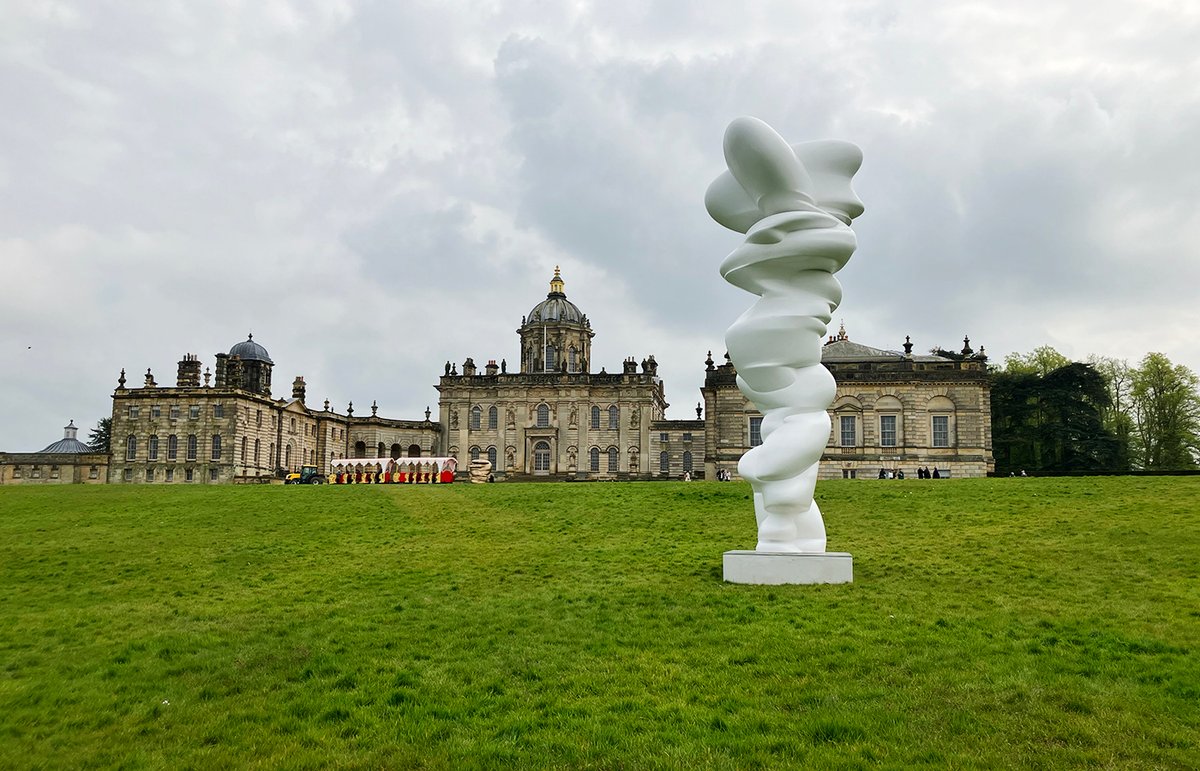Tony Cragg at Castle Howard is the first big contemporary art exhibition at Britain’s best-known, and most-filmed, country house. The show is made up of 10 exterior works by the celebrated Liverpool-born sculptor—set in Castle Howard's matchless gardens and grounds, with views across the Howardian Hills and towards the North York Moors—and 18 indoor pieces (along with 14 works on paper), spaced out across four separate spaces in the vaulting Baroque interiors of the most theatrically composed and positioned of Britain’s great 18th-century treasure palaces.
The Cragg show has been put on by Nicholas Howard—six times great grandson of Charles Howard, 3rd Earl of Carlisle, the creator, with the architects John Vanburgh and Nicholas Hawksmoor of this showplace for paintings, antiquities and sculpture—and his wife, Victoria Barnsley, the publishing pioneer (founder of Fourth Estate and former chief executive of HarperCollins) and sometime trustee of both the Tate Gallery and the National Gallery.
The Howards, stars of the 2022 documentary series Castle Howard: through the seasons, were already familiar with Tony Cragg’s work—in particular his large bronze piece Caldera (2008) in the Markatplatz in Salzburg, Austria—and arranged to work with him after a visit, with the curator Greville Worthington, to the sculptor's base in Wuppertal, north Germany. Cragg took them to see the 30-acre sculpture park he has created over the past three decades at the once-abandoned Villa Waldfrieden, outside Wuppertal, where he shows his own work and that of other artists. There, Nicholas Howard recounted at the show’s opening, “we found an historic house, a wonderful Deco building, … which Tony has lovingly restored. It was surrounded by glades, by lawns, by trees, by sculptures. I thought, ‘This is looking quite familiar.’ So it seemed … Tony Cragg's work should be the work that opened up our new era of contemporary work at Castle Howard.”
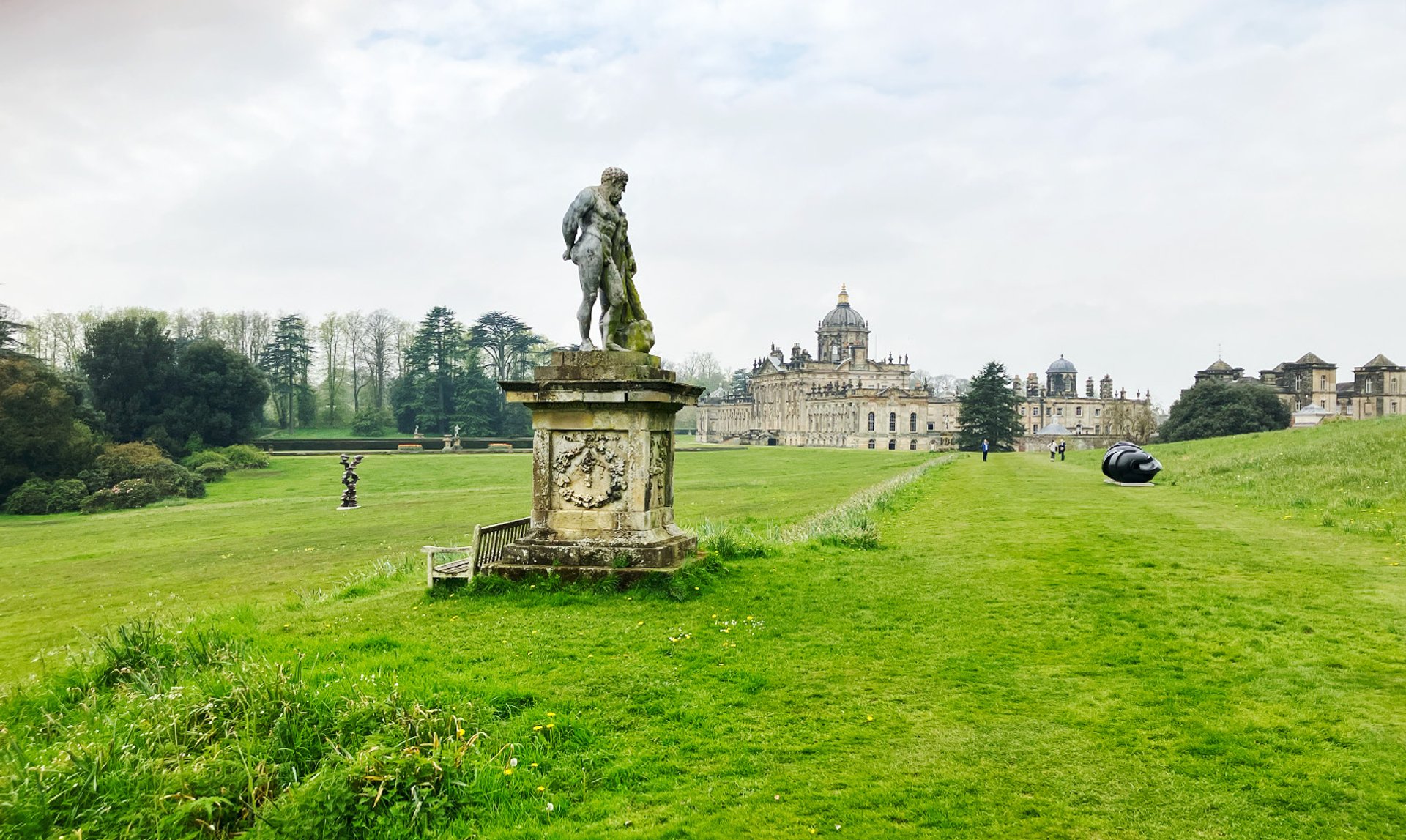
A sculpture park for three centuries: Castle Howard seen from the southeast forms the background to a 1723 copy in lead of the Farnese Hercules by Andrew Carpenter (foreground) with Tony Cragg's Runner (2015, left mid-distance) and Early Forms St Gallen (1997, right mid-distance). The Hercules, in common with other lead statues of its time, was originally painted white in imitation of marble Photograph: The Art Newspaper
The Cragg exhibition—where a leading sculptor's work is on show both in a 300-year-old landscape and in classically proportioned rooms built for the display of paintings and sculpture—puts Castle Howard in company with some of the 21st-century country house pioneers in the field. These include Stoker and Amanda Cavendish, the Duke and Duchess of Devonshire (noted collectors of contemporary art), at Chatsworth, in Derbyshire—the Howards and the Cavendishes intermarried in the mid 19th-century—the late Lord Rothschild at Waddesdon, in Buckinghamshire, and the Marquess of Cholmondeley at Houghton, in Norfolk.
This indoor-outdoor approach, at stately home scale, is one that allows for the vagaries of British summer weather; and lends itself to curation that makes connections between the interiors of historic houses and their gardens—to encourage both looking out from a house, and back towards it from the surrounding grounds. It also allows for the showing of a broad scale of work, from chamber pieces to large-scale compositions. Cragg has been shown at Waddesdon in 2012, for House of cards: an exhibition of contemporary sculpture in response to Chardin; at a 2013 selling show mounted by Sotheby’s at Chatsworth, and at Houghton in a full-dress one-man 2021 exhibition, supported by Thaddaeus Ropac, and curated by Jon Wood (who has curated Tony Cragg at Castle Howard jointly with Greville Worthington).
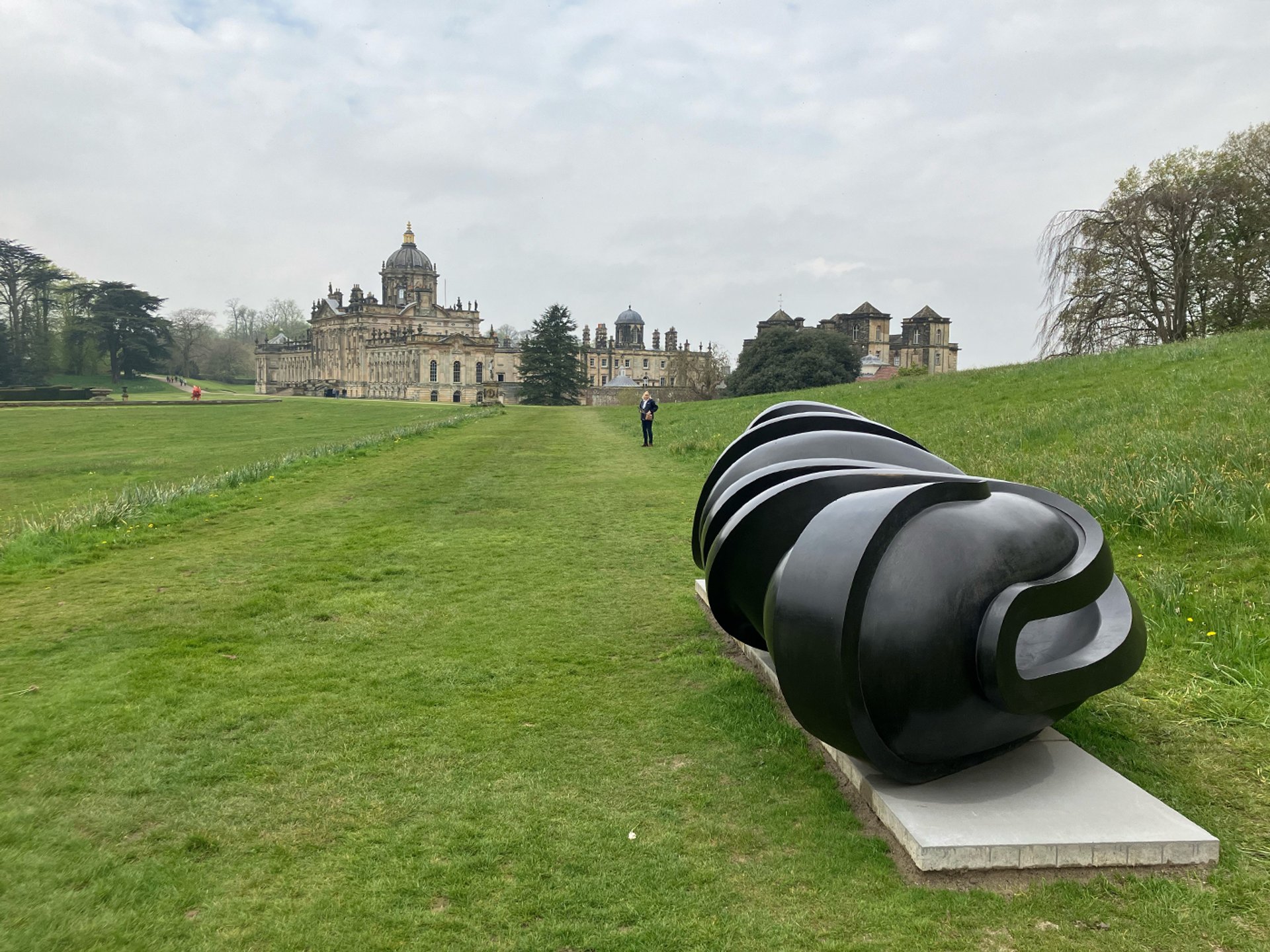
Tony Cragg, Early Forms St Gallen (1997), and the view back to the south front of Castle Howard Photograph: The Art Newspaper
Delicacy of intervention
At Castle Howard it is striking how well Cragg, curators and clients have managed the scale, the frequency and placing of the exterior works, so that sightlines and visual connections are enhanced rather than challenged. In achieving this, the site and its history have necessarily been both an enticement—to show work in an exceptional mature setting—and a challenge: to beware of making overly dramatic gestures in an existing masterpiece of landscape art.
An organic, sensitive, approach is particularly important in the gardens and park at Castle Howard, which was spared the mid 18th-century intervention of Capability Brown and Humphrey Repton, those champions of unrestrained and all-consuming landscape redesigns. The result is that the consciously picturesque landscape envisioned by the third earl of Carlisle and his architects—where Hawksmoor’s astounding colonnaded mausoleum and Vanburgh’s elegant Temple of the Four Winds draw the eye over great sheets of water and along wooded grassy banks—has matured over 300 years into something that clearly evokes its ancestral inspiration: the French master Claude Lorrain’s hauntingly atmospheric landscapes based on Classical stories from Ovid or Vergil, or on the painterly magic of the gardens of the Villa d'Este at Tivoli.
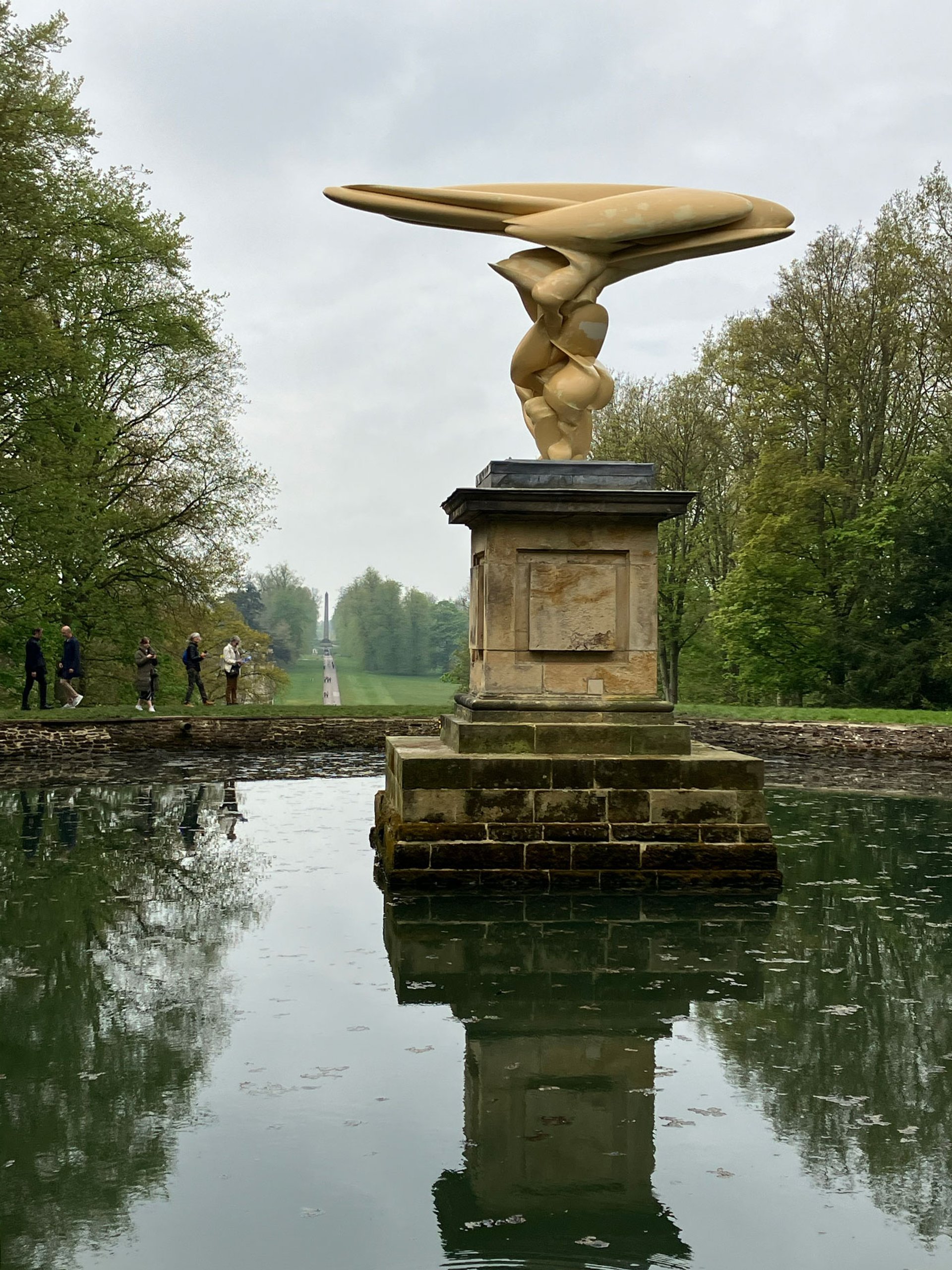
Tony Cragg, Over the Earth (2015), in the centre of the circular reservoir at Castle Howard, with the 1714 obelisk visible at the end of the vista Photograph: The Art Newspaper
A sculpture park for three centuries
Castle Howard has in some ways been a sculpture park since soon after works began in 1702. The towering obelisk erected to celebrate the victory of the Duke of Marlborough at the Battle of Blenheim in 1714 later served additionally as a memorial to the third Earl of Carlisle. Then there are the remarkable array of lodges and follies along the drive and in the park to the south of the house, including the pyramid, designed by Hawksmoor and home to a memorial to Lord William Howard, founder of the Carlisle line of Howards. In the gardens proper and in and around the house, there has always been a collection of statuary, some of it brought back from 18th-century grand tours. Inside the house, the third earl and his descendants collected a rich assembly of antiquities, including a notable collection of Classical busts and statues.
The house has been a media star for more than 40 years, thanks to the making of the 1981 Granada television adaptation of Evelyn Waugh's Brideshead Revisited, starring Jeremy Irons, Anthony Andrews and Laurence Olivier; a film remake of the novel in 2008; and then the 2020 season of the cult Regency TV drama Bridgerton.
Layered works
Cragg, who made land art early in his career, had a break-out moment in 1988, when he represented Britain at the Venice Biennale and won the Turner Prize in the same year. His classic works are built in layers, organised like geological strata of sedimentary rocks, using stacked layers of plywood before being sanded into final form and cast in bronze or fibreglass. It is a decidedly elemental approach, one rooted in nature: “All of the work and the things I make,” Cragg said at the show’s opening, “ is somehow... caught between what human beings make anyway, the stuff we build around us and use, and the nature that surrounds us”.
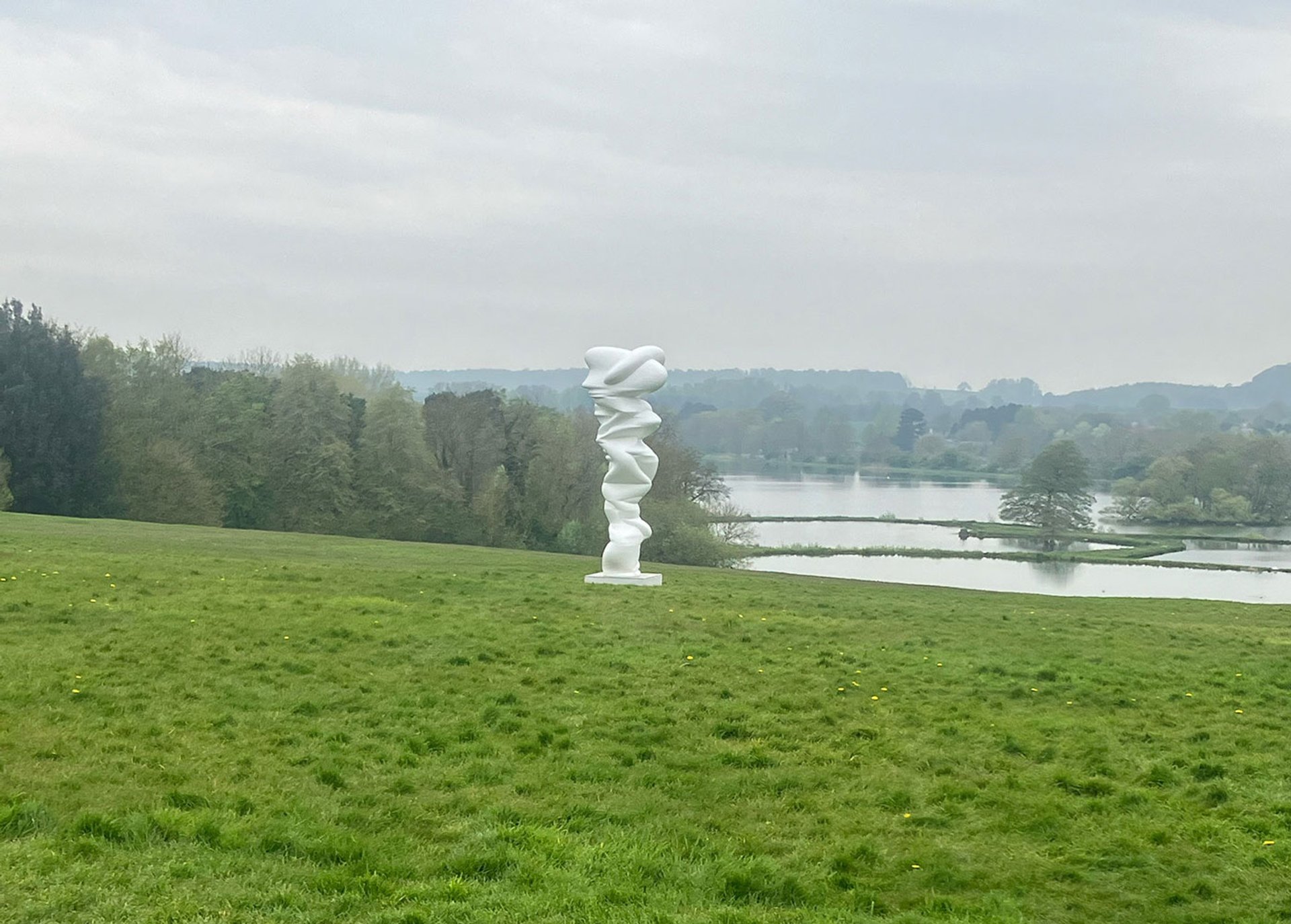
Tony Cragg, Senders (2018), seen in the grounds of Castle Howard, looking north over the Great Lake toward the North York Moors national park Photograph: The Art Newspaper
On the north side of the house, two tall, layered, pieces, placed on the sloping lawn below the entrance courtyard, offer a frame to the far-reaching view to the north across the Great Lake, the village of Coneysthorpe, and towards the moors beyond. Points of View (2018) is in gleaming stainless steel, and catches the eye of the visitor descending the steep slope from Ray Wood to the east of the house. The 6.5-metre tall Senders (2018) is in white fibreglass, a subtle nod to the original appearance of the 17th and 18th-century lead statues of gods and goddesses that are to be found around the gardens and grounds—pieces that were formerly painted white to resemble marble. (In 2021, English Heritage started restoring this white paint treatment to the lead statues by John Cheere at Wrest Park, in Bedfordshire.)
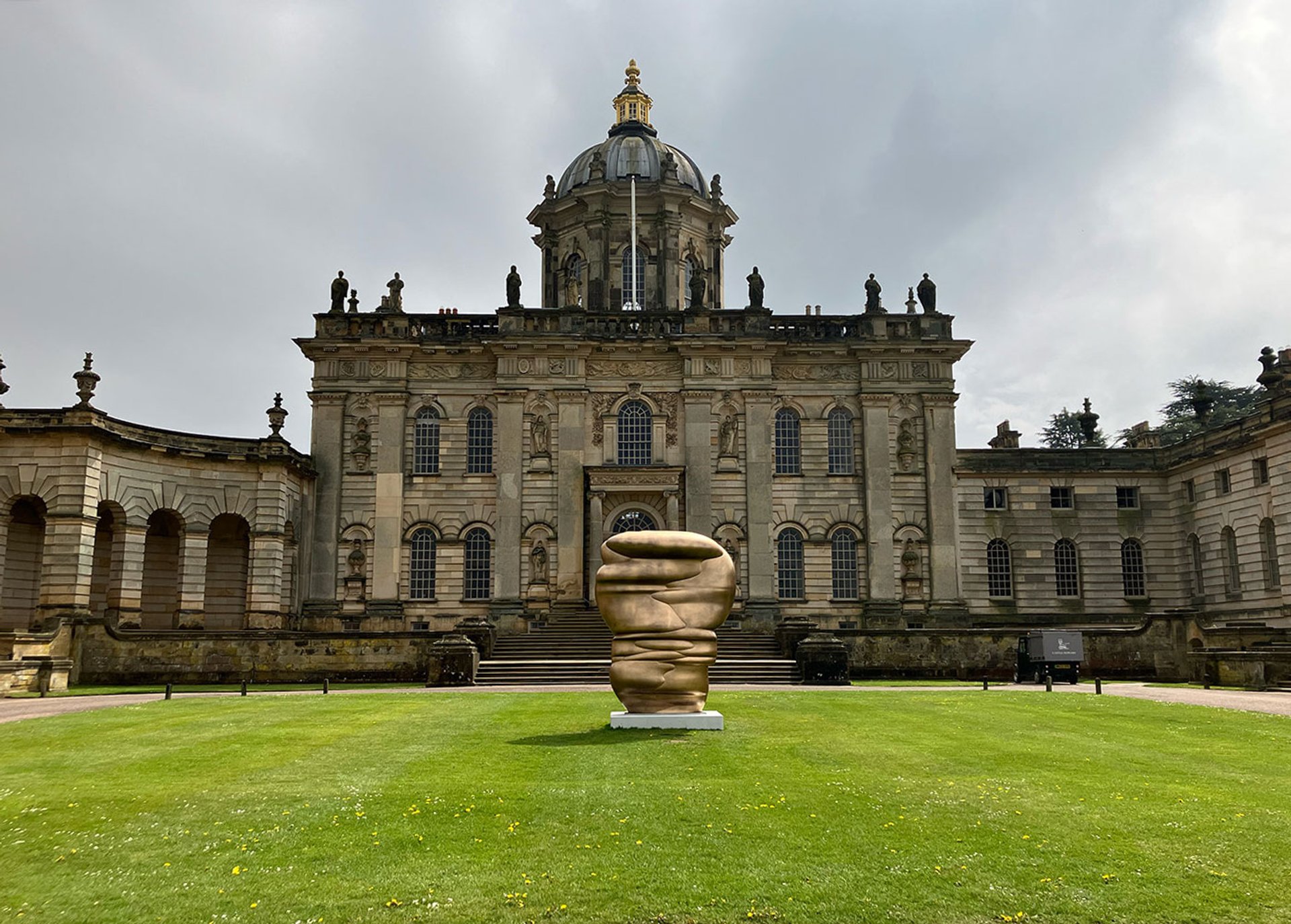
Tony Cragg, Masks (2024), in the entrance forecourt of Castle Howard Photograph: The Art Newspaper
At the heart of the entrance courtyard stands Cragg's monumental new bronze piece Masks (2024), whose solidity, compressing, in Jon Wood's words, "two forms [head and body-like] into each other to create an image of inseparability", matches its four-square position and the stony strength of the entrance façade, populated with an array of classical statuary of urns, gods and goddesses, massed in niches and along the house's parapet.
On the south side of the house, a new painted aluminium piece, Industrial Nature (2024), is most artfully placed at the end of the parterre nearest to the house. Its position in relation to the statuary and to the massive mid 19th-century Atlas fountain is apparent when approaching the work from the house, but only on reaching and examining the piece does the viewer understand its role as a link to the next large exterior work: Runner (2015). This tall stacked piece in bronze stands to the east on ground that slopes down to the south lake and acts as a sighter in turn to the Mausoleum, a mile distant, beyond the lake, where members of the Howard family have been buried since 1744. This alignment reveals the role of Industrial Nature and Runner in marking and drawing out the historic landscape.

Channeling Claude Lorrain: Tony Cragg, Runner (2015), set in front of the south lake at Castle Howard, with Nicholas Hawksmoor's mausoleum in the distance Photograph: The Art Newspaper
Close-up, Runner offers another moment of serendipity: it has openings in its intertwined, stacked, threads through which the visitor may chance on a most picturesque pair of coups d’oeil: in one direction towards the ineffable mausoleum, a slice of its base nicely obscured by the trees that hang over the lakeside; in another, back to the 300ft-long south front of the house, adorned with pilasters, the colour of its well-weathered stone enhanced by the sculpture’s rich dark bronze.
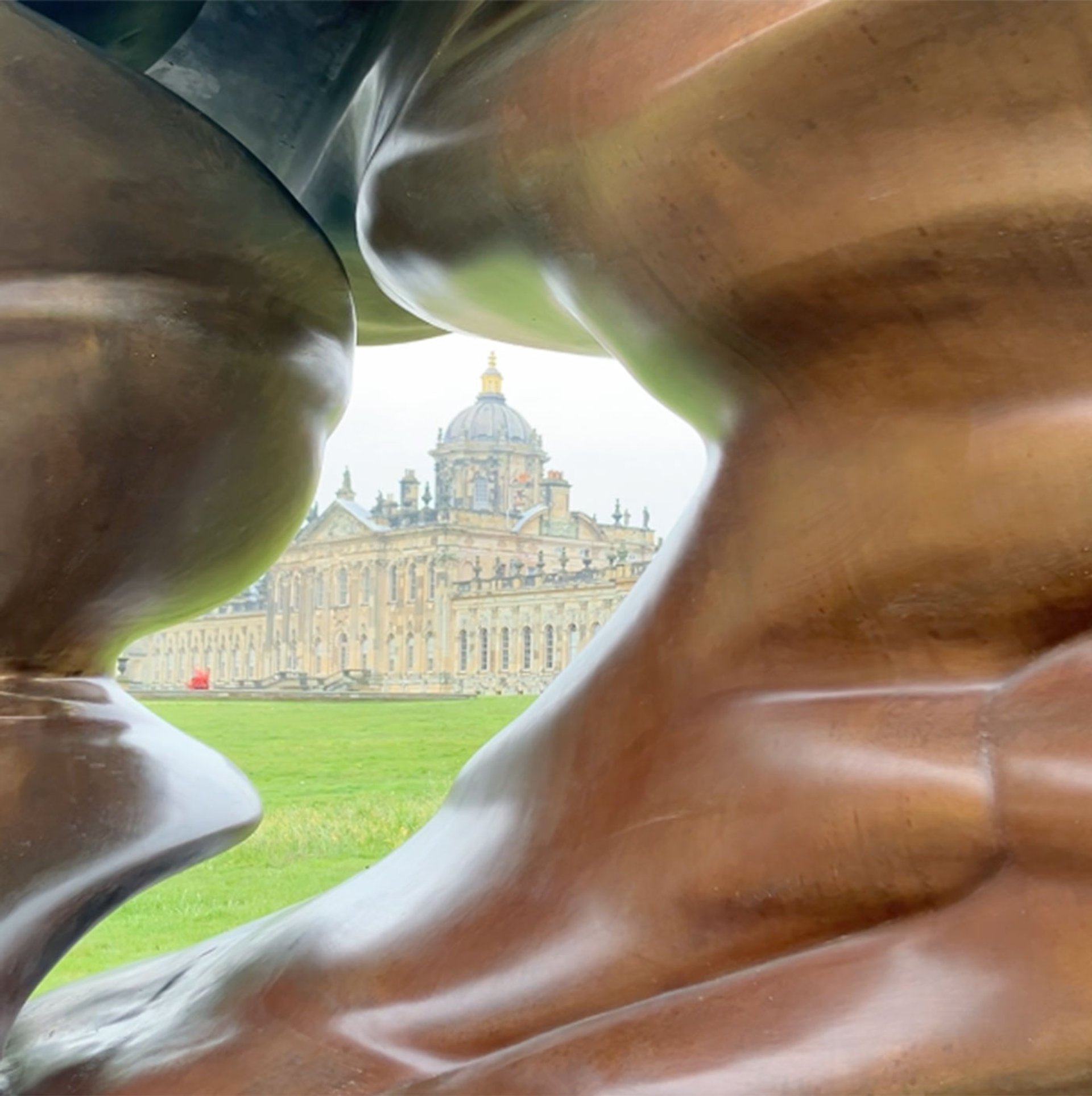
Serendipity: Tony Cragg's Runner (2015) frames the view back to the south front of Castle Howard Photograph: The Art Newspaper
The one recumbent piece among Cragg's outdoor pieces, Early Forms St Gallen (1997), a 2.5-tonne bronze work made up of a sequence of curves, outlines and edges, is most subtly placed. Looked at from the sloping bank above, its elongated shape nicely mirrors the form of the South Lake below. Looked at from the path to the east, the piece serves to draw the eye back down the path to the house, and once more along the elegantly fenestrated south façade.

Most subtly placed: Tony Cragg, Early Forms, St Gallen (1997), overlooking the South Lake at Castle Howard Photograph: The Art Newspaper
At the Temple of the Winds—situated on a bluff with commanding views over the waterfalls down to the park bridge and the mausoleum beyond and a film-maker's favourite in Castle Howard's performances on celluloid and video—artist and curators have pulled off a moment of magic by placing Eroded Landscapes (1999) at the heart of this small cuboid building, so that this sculpture of stacked sand-blasted bottles and glasses on horizontal sheets of glass can be seen, through the temple's glazed doors, from all quarters. The sense of surprise, as if coming upon a moment of creation in a particularly splendid hermit's grotto, is as arresting as the conjunction of glass sculpture and marble floor, the sculpture rising up towards the temple's coffered ceiling, its walls inset with busts of Classical worthies and adorned with decorative swags and mouldings.
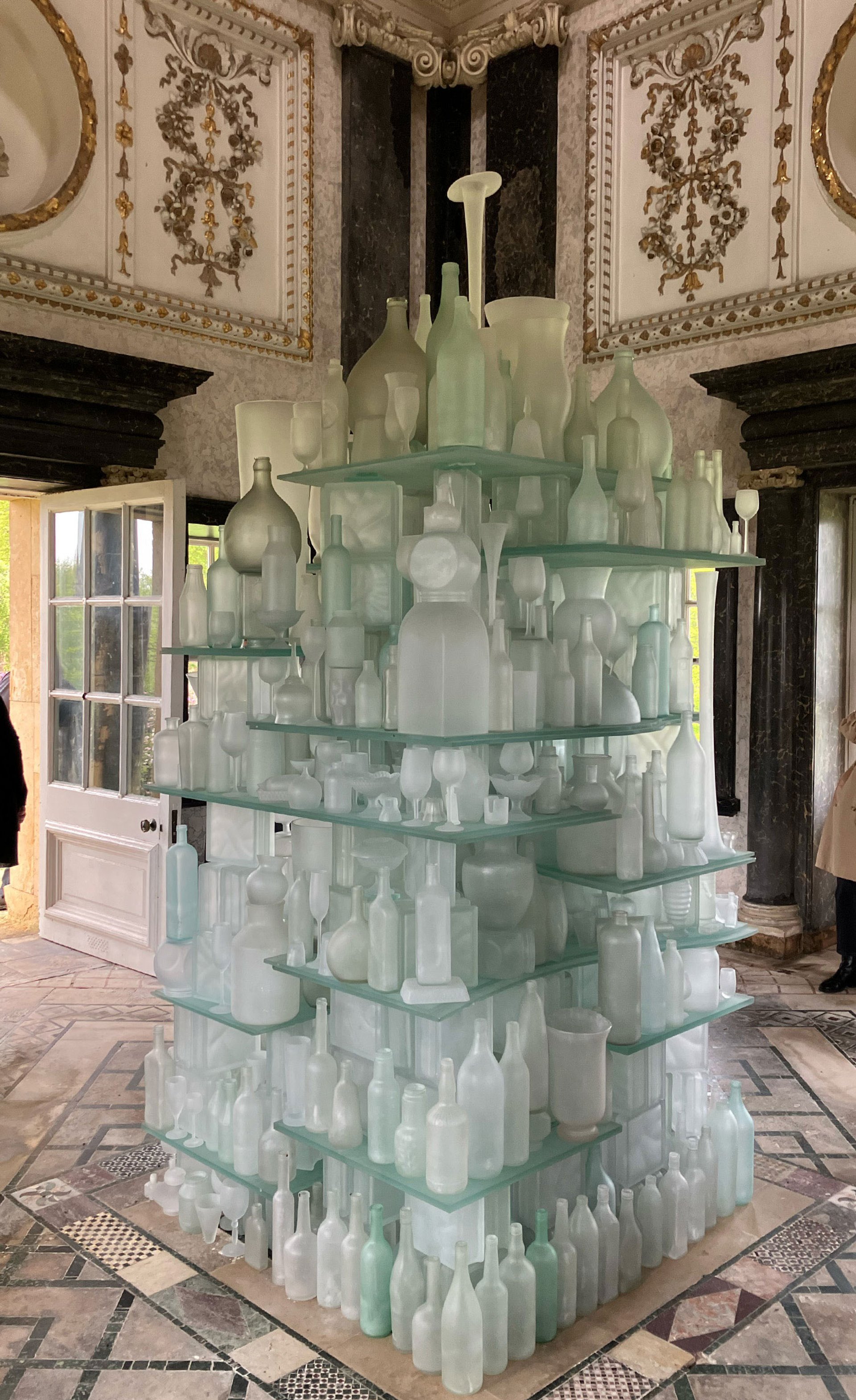
A moment of magic: Tony Cragg, Eroded Landscape (1999), in the Temple of the Four Winds at Castle Howard Photograph: The Art Newspaper
in the upper heights of Ray Wood, artist and curators have boldly placed Over the Earth (2015), a winged design in fibreglass, set in the middle of the circular reservoir that feeds by gravity the displays of the Atlas fountain and the 45ft-tall South Lake fountain. Over the Earth commands the long-straight drive that runs in front of the entrance facade and was put in place by running a scaffold across the reservoir to the plinth at its heart. This particular installation was a demonstration, if one were needed, of the massive logistical challenges of mounting an exhibition of this scale, with some pieces in portable fibreglass but others in weighty bronze.
Colour codes
The interior element of the exhibition is broken into four parts. In the extraordinary four-storey theatre of the Great Hall, artist and curators have placed three strongly coloured pieces from Cragg's Early Forms series—McCormack (2007), Outspan (2008), and Red Square (2015), to contrast with the sober white and black marble paving. They are seen to best advantage from the upper galleries of the hall, from which the curvaceous shell-like Outspan sits very happily in perpendicular alignment with the scrolled volutes of the giant marble statuary shrine it faces.
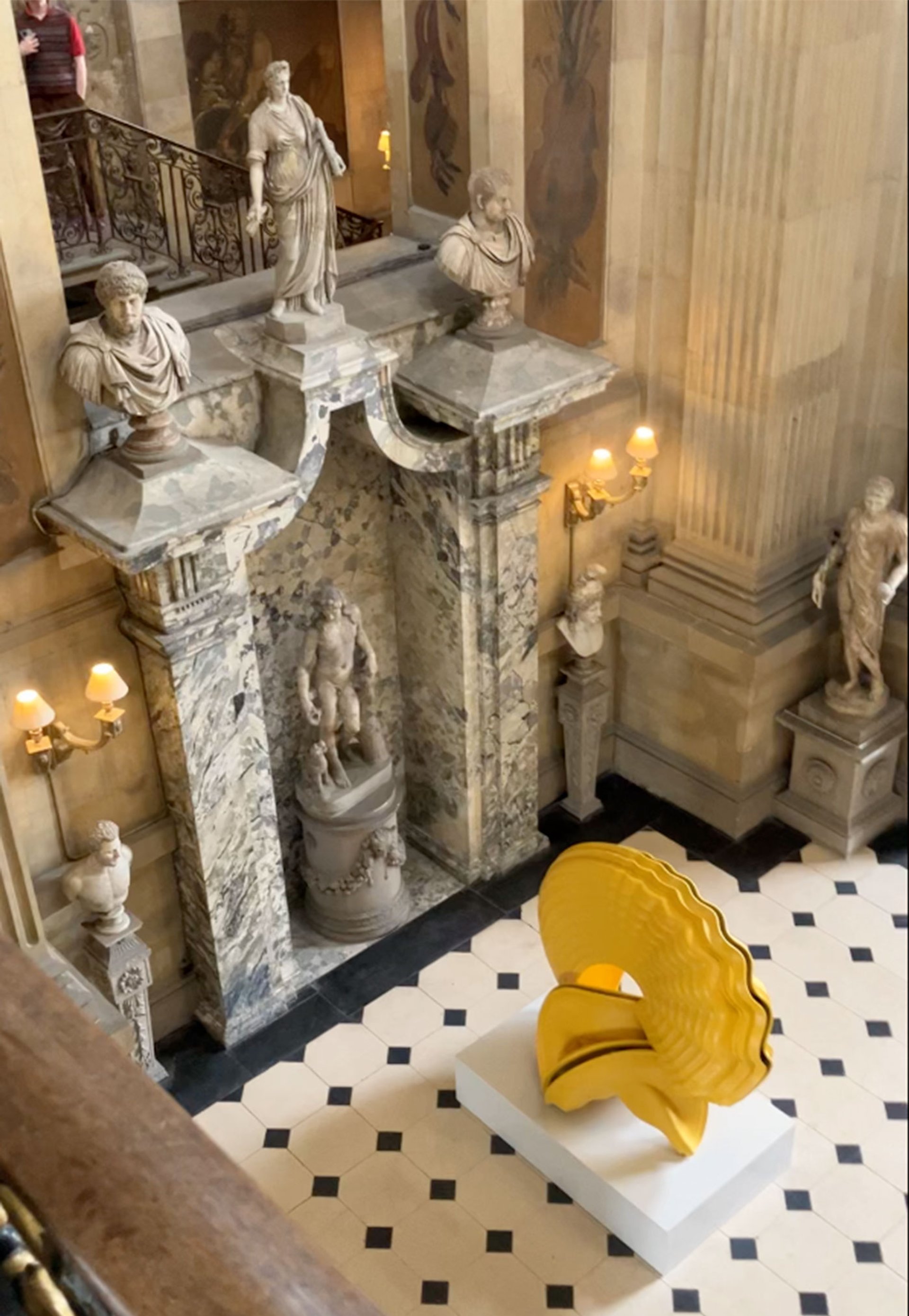
Tony Cragg, Outspan (2008), in the Great Hall, Castle Howard Photograph: The Art Newspaper
Seeing the internal installations at Castle Howard is to be reminded still of the way the house rose from the ashes of a catastrophic fire in 1940, which badly damaged the great hall, caused the dome to collapse, and destroyed two thirds of the enfillade of splendid rooms along the south front of the house. The world assumed that Nicholas Howard's father, George Howard, sometime chairman of the BBC, and his family would never move back in. They duly did and made some imaginative and sympathetic repairs and restorations with the architect Julian Bicknell and the artist Felix Kelly, and the central block was re-roofed in the mid-1990s. The High South bedroom, once the bedroom for royal guests, was gutted in the fire, and its still bare masonry walls and those of the neighbouring room to the east, make the most inviting and adaptable temporary exhibition rooms. In High South, Cragg has a display of powerful recent glass pieces made with the glaziers of Murano.
Coming to the interior of Castle Howard after enjoying the atmospheric splendours of its landscape is to be reminded not just of the importance of its historic art collection but also of the high taste and artistic talent that has run in the family in recent generations. The chapel in the west wing is a masterpiece of arts and crafts redecoration, with windows designed by Edward Burne-Jones and manufactured by Morris and Co. The work was done for Lord Lanerton, brother of the 8th Earl, while George Howard, the 9th Earl, was a considerable amateur artist himself and friend and patron of Burne-Jones, Morris and Walter Crane. George Carlisle's grand-daughter Winifred Roberts, first wife of Ben Nicholson, and a notable impressionist and colourist in her own right, known by her married name, is one of the few artists to have works on show simultaneously at Tate Britain and Tate Modern.
That feel for the look of things, for rightness of presentation, has clearly carried down to the approach the present generation of Howards has taken to the Cragg show. The exhibition is clearly marked and signposted, and the fold-out guide is a model of its kind, with a good map, intelligent essays and captions, well laid out, and printed on a weight and strength of paper suitable to last for a day's visit and beyond. A QR code takes visitors to a playlist of YouTube videos on which Nicholas Howard narrates a brief commentary to each piece.
At the show's opening, Howard caught the combination of serendipity and sympathy that is to be found in exploring the exhibition—one where landscape and sculptures work in harmony—when he described the experience of living with the show since its recent installation. “I knew one or two of [Cragg's] pieces already, but having now lived with them, over 20 of them, for a few weeks, it really feels as if they belong here ... Tony has placed the pieces so that they don't feel like an intervention, but more something that's grown up organically around the place.”


